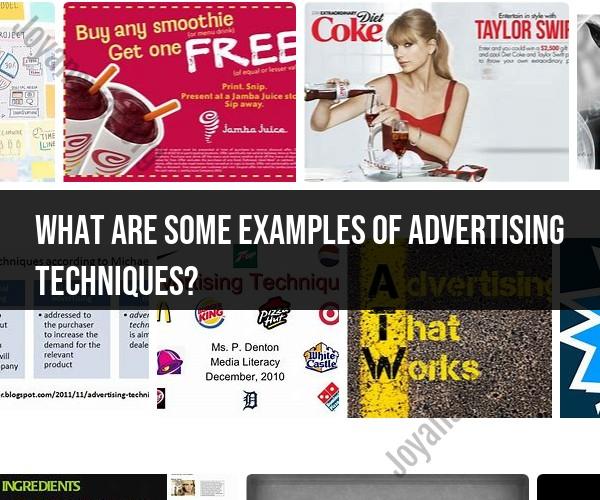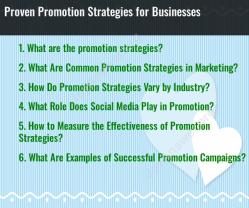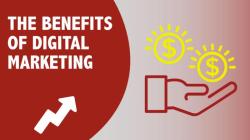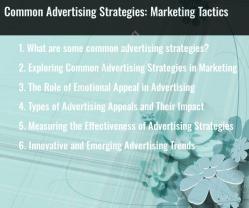What are some examples of advertising techniques?
Advertising techniques are strategies used by advertisers and marketers to capture the attention of their target audience, persuade them to take action, and promote a product, service, or idea. Here are some common advertising techniques, along with examples:
Emotional Appeal:
- Example: A commercial for a children's charity showing images of underprivileged children smiling and playing, aiming to evoke empathy and compassion in viewers to donate.
Testimonials and Endorsements:
- Example: An athlete promoting a sports drink, highlighting how it helps improve their performance, which may persuade consumers to try the product.
Bandwagon Effect:
- Example: Ads that emphasize "Join the thousands who already use our product" to create a sense of belonging and popularity.
Fear Appeal:
- Example: An advertisement for home security systems that illustrates the potential dangers of not having one, instilling fear and motivating viewers to take action.
Humor:
- Example: Commercials like those by Geico with talking animals or the Old Spice "The Man Your Man Could Smell Like" campaign use humor to make the brand memorable.
Sex Appeal:
- Example: Perfume or clothing ads featuring attractive models to associate the product with desirability and attractiveness.
Scarcity:
- Example: "Limited-time offer" or "Only 5 left in stock" messages create a sense of urgency, encouraging consumers to make a purchase quickly.
Comparison and Competitive Advertising:
- Example: Ads that directly compare a product to a competitor's, highlighting why their product is superior. For instance, Pepsi's "Pepsi Challenge" campaign.
Storytelling:
- Example: Ads that tell a compelling narrative, such as Coca-Cola's holiday ads with heartwarming stories, evoke emotional responses and connect with viewers.
Celebrity Endorsement:
- Example: A famous actor promoting a luxury car, implying that owning the car will make you as glamorous as the celebrity.
Product Demonstrations:
- Example: TV infomercials that show a product's effectiveness through demonstrations, like a stain remover removing tough stains.
Loyalty Programs and Rewards:
- Example: Fast-food chains offering loyalty cards with discounts and free items to encourage repeat business.
Influencer Marketing:
- Example: Social media influencers endorsing products to their followers, leveraging their credibility and reach.
Nostalgia:
- Example: Ads that evoke feelings of nostalgia, like Coca-Cola's vintage holiday ads, aiming to connect with viewers' emotions.
Problem-Solution Approach:
- Example: Ads that present a problem and then introduce the advertised product or service as the solution, such as headache medicine commercials.
Interactive Marketing:
- Example: Online quizzes or polls that engage users and collect data while subtly promoting a product or brand.
User-Generated Content:
- Example: Brands encouraging customers to share their experiences and content, fostering a sense of community and authenticity.
These are just a few examples of advertising techniques. Effective advertising often combines multiple strategies to create compelling and persuasive campaigns that resonate with the target audience. The choice of technique depends on the product, the audience, and the marketing goals.
Advertising Techniques Unveiled: A Comprehensive Overview
Advertising is a powerful tool that businesses use to promote their products and services. It can be seen in a variety of forms, including television commercials, radio ads, print ads, and online ads. Advertising techniques are used to persuade consumers to buy a product or service, or to consider a particular brand.
There are many different advertising techniques that can be used, but some of the most common include:
- Repetition: Repetition is one of the most effective advertising techniques. It involves repeating a message over and over again until consumers become familiar with it and are more likely to remember it.
- Slogans: Slogans are short, catchy phrases that are used to sum up a brand or product. They are often easy to remember and can be very effective in persuading consumers.
- Emotional appeals: Emotional appeals are used to evoke feelings in consumers, such as happiness, sadness, or fear. These feelings can then be associated with the product or brand, making consumers more likely to buy it.
- Bandwagon appeals: Bandwagon appeals are used to make consumers feel like they need to buy a product or service because everyone else is doing it. This can be a very effective technique, especially for popular products and brands.
- Celebrity endorsements: Celebrity endorsements are used to associate a product or brand with a popular celebrity. This can make consumers more likely to buy the product or service because they want to be like their favorite celebrity.
The Power of Persuasion: Examining Effective Advertising Strategies
Effective advertising strategies are based on a deep understanding of human psychology. Advertisers use this knowledge to create messages that are more likely to persuade consumers to buy their products or services.
One of the most important principles of effective advertising is the principle of social proof. This principle states that people are more likely to do something if they see other people doing it. This is why advertisers often use testimonials from satisfied customers in their ads.
Another important principle of effective advertising is the principle of scarcity. This principle states that people are more likely to want something if they think it is scarce or limited in supply. This is why advertisers often use limited-time offers and sales in their ads.
From Slogans to Psychology: Examples of Advertising Techniques
Here are a few examples of how advertising techniques are used in real-world ads:
- Repetition: The slogan "Just do it" is repeated over and over again in Nike commercials. This helps to make the slogan familiar to consumers and to associate it with the Nike brand.
- Slogans: The slogan "Think different" is used to sum up the Apple brand. It suggests that Apple products are innovative and unique, and that they are used by people who are creative and independent.
- Emotional appeals: The Coca-Cola commercial "Share a Coke" uses emotional appeals to evoke feelings of happiness and nostalgia in consumers. The ad shows people sharing Coke with their loved ones and creating happy memories.
- Bandwagon appeals: The ad for the new iPhone often uses bandwagon appeals by showing people from all walks of life using and enjoying the product. This makes consumers feel like they need to buy the iPhone because everyone else is doing it.
- Celebrity endorsements: The perfume brand Chanel often uses celebrity endorsements in its ads. The ads feature celebrities such as Nicole Kidman and Marion Cotillard using and endorsing the Chanel perfume brand.
These are just a few examples of how advertising techniques are used to persuade consumers to buy products and services. By understanding the different advertising techniques that are used, consumers can be more critical of the messages they are exposed to and make more informed decisions about what they buy.










